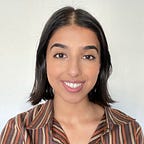Why I Cried in a Bookstore in 2021
It’s been over a year since I’ve been to a party or inside a local bookstore, so yesterday I decided to get wild and stop in at Book Warehouse in Vancouver for the first time. Sanitizer in a Dollarama spray bottle, friendly staff with overgrown hair, and shelves upon shelves of carefully-chosen books placed at eye level. I’m 5'4" so I have to tip-toe to reach my favourites, so I was thrilled. I’ve been to the local Indigo a few times, so I’ve noticed (with pride) the year’s growing diversity on display shelves and Heather’s Picks, so much so that I’ve developed a reflex that looks for South Asian names and faces on books about power. All this, and I still wasn’t prepared for where I found myself crying: the kids section.
I grew up a closet atheist in a family that somehow socialized exclusively with other Pakistani-Muslims in the whitest place on Earth: Calgary, Alberta. There wasn’t much I related to in my surroundings, so I read books. I spent hours throwing myself into the lives of the characters in whichever book I dug my nose into. What I didn’t realize was happening — I was living as white character after white character — subconsciously reinforced the belief that my life would only ever be interesting if I grew up to be a white woman. I never saw a brown face on the cover of a book. The first time I read a story about a brown Muslim woman was when I was 13. A Thousand Splendid Suns, a deeply authentic and vulnerable story of shared female trauma set in post-Soviet Afghanistan, was the closest I’d gotten to seeing myself on the page (unless you count pretending to read the Quran on Sundays).
Those first 13 years, I had read hundreds of books without once coming across a protagonist who looked like me. When I walked into the youth section Book Warehouse and saw endless shelves of books with black and brown protagonists on the covers, I’ll admit it: I teared up. Being a screenwriter, I’m used to recalling how few Desi protagonists I saw on television, but it wasn’t until that day that I realized how much more I was missing in the literary world. At least I’d seen Little Mosque on the Prairie before I was 10.
I’ve gotten used to seeing books by and for women of colour in adult pop culture sections this last year since the #BLM movement brought forth a tidal wave of organized calls for diversity, but this was something new. As I browsed my way from the older teens’ sections down to the children’s bedtime story sections, I kept expecting the simulation to end and revert back to the world of white protagonists. But the racial diversity kept coming, and I had one very clear thought in my mind: my kids are never going to believe me when I tell them I went 13 years without reading about a single South Asian hero.
And this thought comforts me to no end.
After I asked for some Kleenex from the alarmed sales clerk, I took a breath. My childhood syllabus was a long series of badass white characters marching forward with a single story of brown-skinned tragedy among them. On these 2021 shelves, in the faces of these kids of colour, I saw something new; I saw regular stories about little girls and boys who wanted to be journalists, who wanted to get their parents back together, who wanted to plant a tree. Their stories weren’t about how their culture or race were their trauma, their stories were about life. Extraordinarily ordinary life. And that is the shit I wanna see for my kids. Stories that define their lives as something that can be as unique and familiar as the stories of everyone around them. Extraordinarily ordinary stories, that’s what my kids will get.
